Theory Assessment: Medical Conditions and Nursing Implications
VerifiedAdded on 2021/04/21
|22
|4412
|30
Homework Assignment
AI Summary
This theory assessment covers a wide array of medical conditions, exploring their pathophysiology, signs, symptoms, and nursing implications. The assessment begins with an examination of carbon monoxide poisoning, including its effects on the body and associated symptoms. It then proceeds to discuss cerebrovascular accidents (strokes), epilepsy, Raynaud's phenomenon, asthma, and pneumonia, detailing their underlying mechanisms and clinical presentations. The assessment further delves into peptic ulcers, cirrhosis of the liver, gout, and carpal tunnel syndrome, examining their causes, symptoms, and management strategies. Nephrotic syndrome, urinary tract infections, prostatic cancer, diabetes mellitus, hypothyroidism, systemic lupus erythematosus (SLE), Hodgkin's disease, Ménière's disease, and senile cataracts are also analyzed. The assessment concludes with scenarios involving the Glasgow Coma Scale, contraindications in nursing, and admission and discharge processes. This document provides a comprehensive overview of various medical conditions and their associated nursing care.
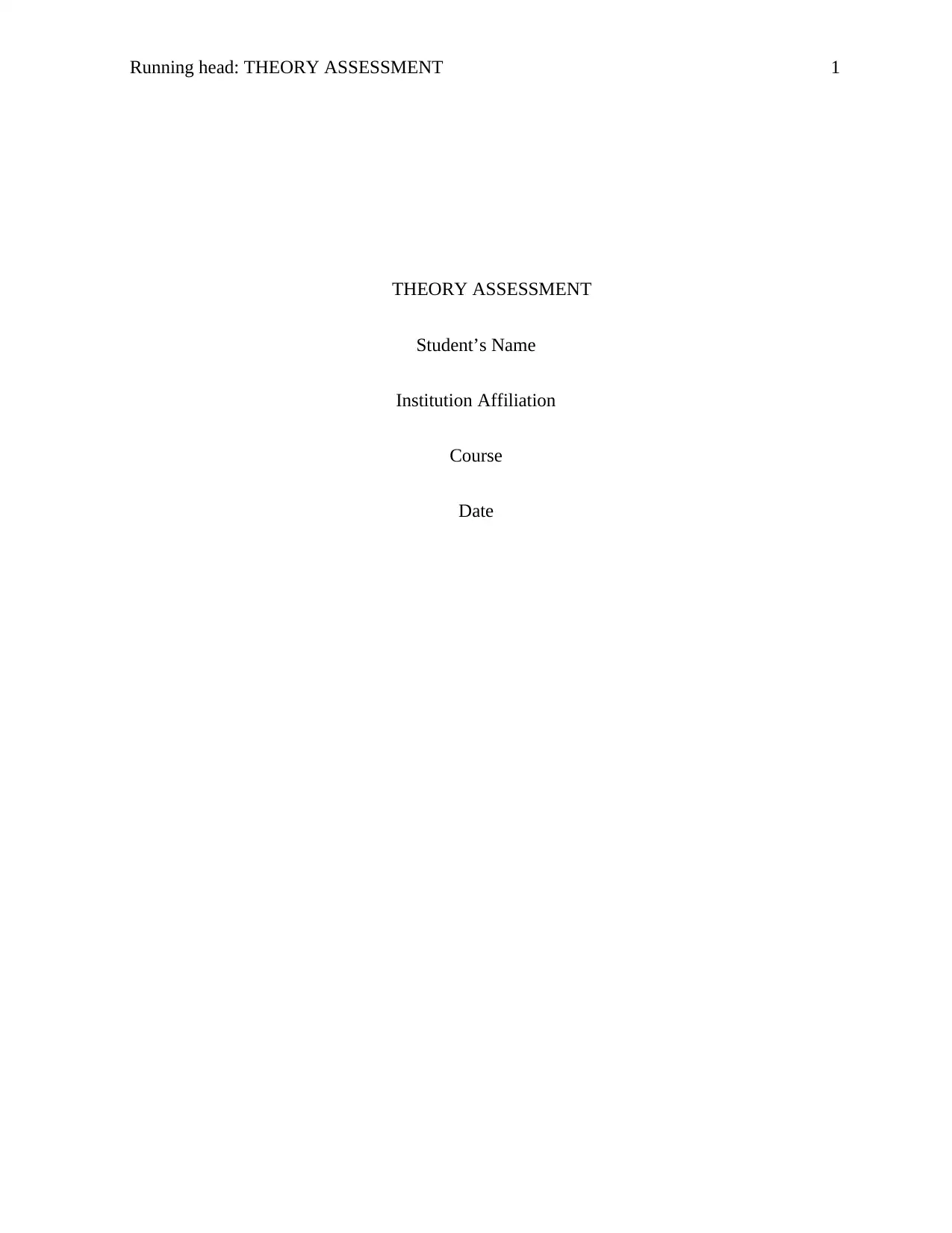
Running head: THEORY ASSESSMENT 1
THEORY ASSESSMENT
Student’s Name
Institution Affiliation
Course
Date
THEORY ASSESSMENT
Student’s Name
Institution Affiliation
Course
Date
Paraphrase This Document
Need a fresh take? Get an instant paraphrase of this document with our AI Paraphraser
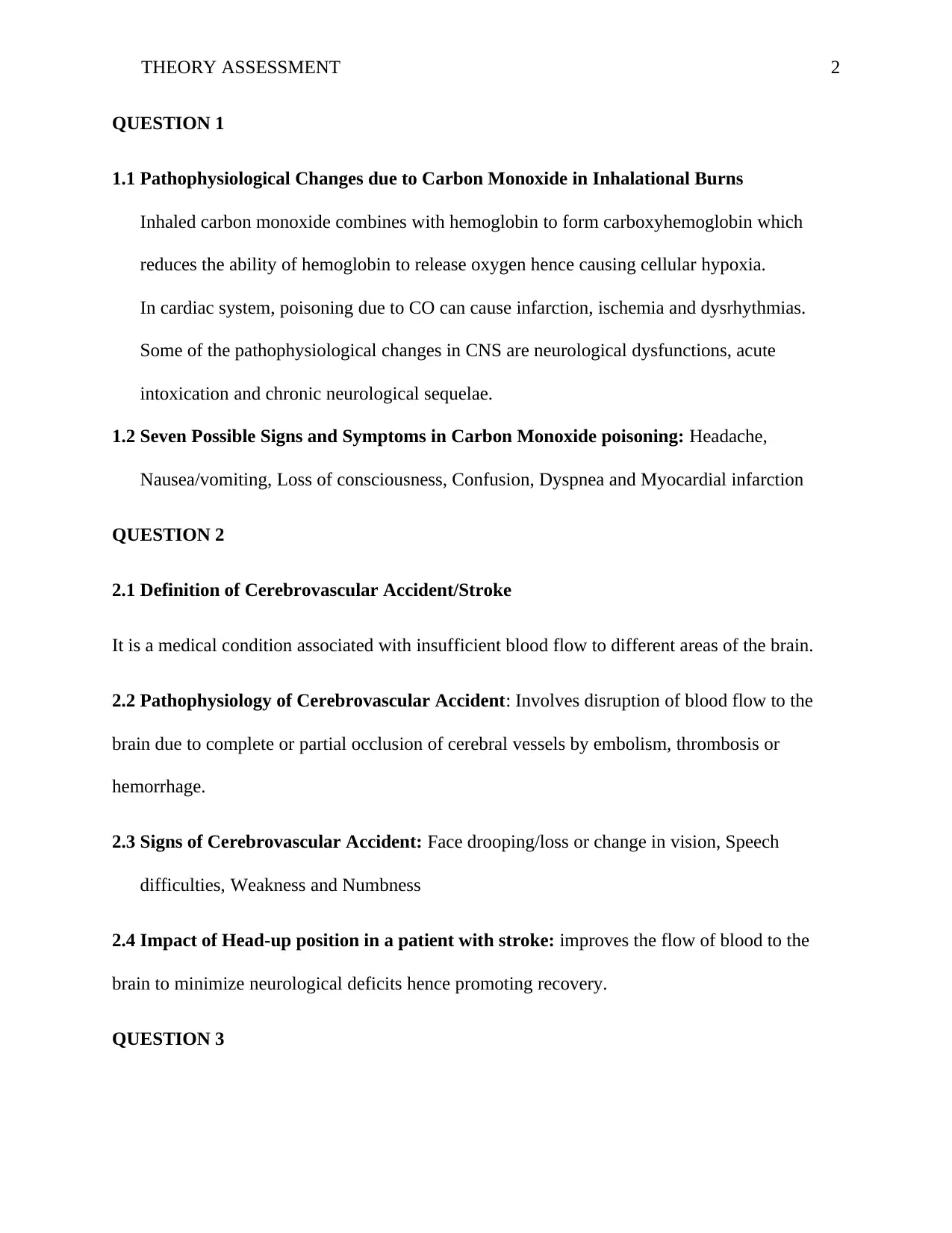
THEORY ASSESSMENT 2
QUESTION 1
1.1 Pathophysiological Changes due to Carbon Monoxide in Inhalational Burns
Inhaled carbon monoxide combines with hemoglobin to form carboxyhemoglobin which
reduces the ability of hemoglobin to release oxygen hence causing cellular hypoxia.
In cardiac system, poisoning due to CO can cause infarction, ischemia and dysrhythmias.
Some of the pathophysiological changes in CNS are neurological dysfunctions, acute
intoxication and chronic neurological sequelae.
1.2 Seven Possible Signs and Symptoms in Carbon Monoxide poisoning: Headache,
Nausea/vomiting, Loss of consciousness, Confusion, Dyspnea and Myocardial infarction
QUESTION 2
2.1 Definition of Cerebrovascular Accident/Stroke
It is a medical condition associated with insufficient blood flow to different areas of the brain.
2.2 Pathophysiology of Cerebrovascular Accident: Involves disruption of blood flow to the
brain due to complete or partial occlusion of cerebral vessels by embolism, thrombosis or
hemorrhage.
2.3 Signs of Cerebrovascular Accident: Face drooping/loss or change in vision, Speech
difficulties, Weakness and Numbness
2.4 Impact of Head-up position in a patient with stroke: improves the flow of blood to the
brain to minimize neurological deficits hence promoting recovery.
QUESTION 3
QUESTION 1
1.1 Pathophysiological Changes due to Carbon Monoxide in Inhalational Burns
Inhaled carbon monoxide combines with hemoglobin to form carboxyhemoglobin which
reduces the ability of hemoglobin to release oxygen hence causing cellular hypoxia.
In cardiac system, poisoning due to CO can cause infarction, ischemia and dysrhythmias.
Some of the pathophysiological changes in CNS are neurological dysfunctions, acute
intoxication and chronic neurological sequelae.
1.2 Seven Possible Signs and Symptoms in Carbon Monoxide poisoning: Headache,
Nausea/vomiting, Loss of consciousness, Confusion, Dyspnea and Myocardial infarction
QUESTION 2
2.1 Definition of Cerebrovascular Accident/Stroke
It is a medical condition associated with insufficient blood flow to different areas of the brain.
2.2 Pathophysiology of Cerebrovascular Accident: Involves disruption of blood flow to the
brain due to complete or partial occlusion of cerebral vessels by embolism, thrombosis or
hemorrhage.
2.3 Signs of Cerebrovascular Accident: Face drooping/loss or change in vision, Speech
difficulties, Weakness and Numbness
2.4 Impact of Head-up position in a patient with stroke: improves the flow of blood to the
brain to minimize neurological deficits hence promoting recovery.
QUESTION 3
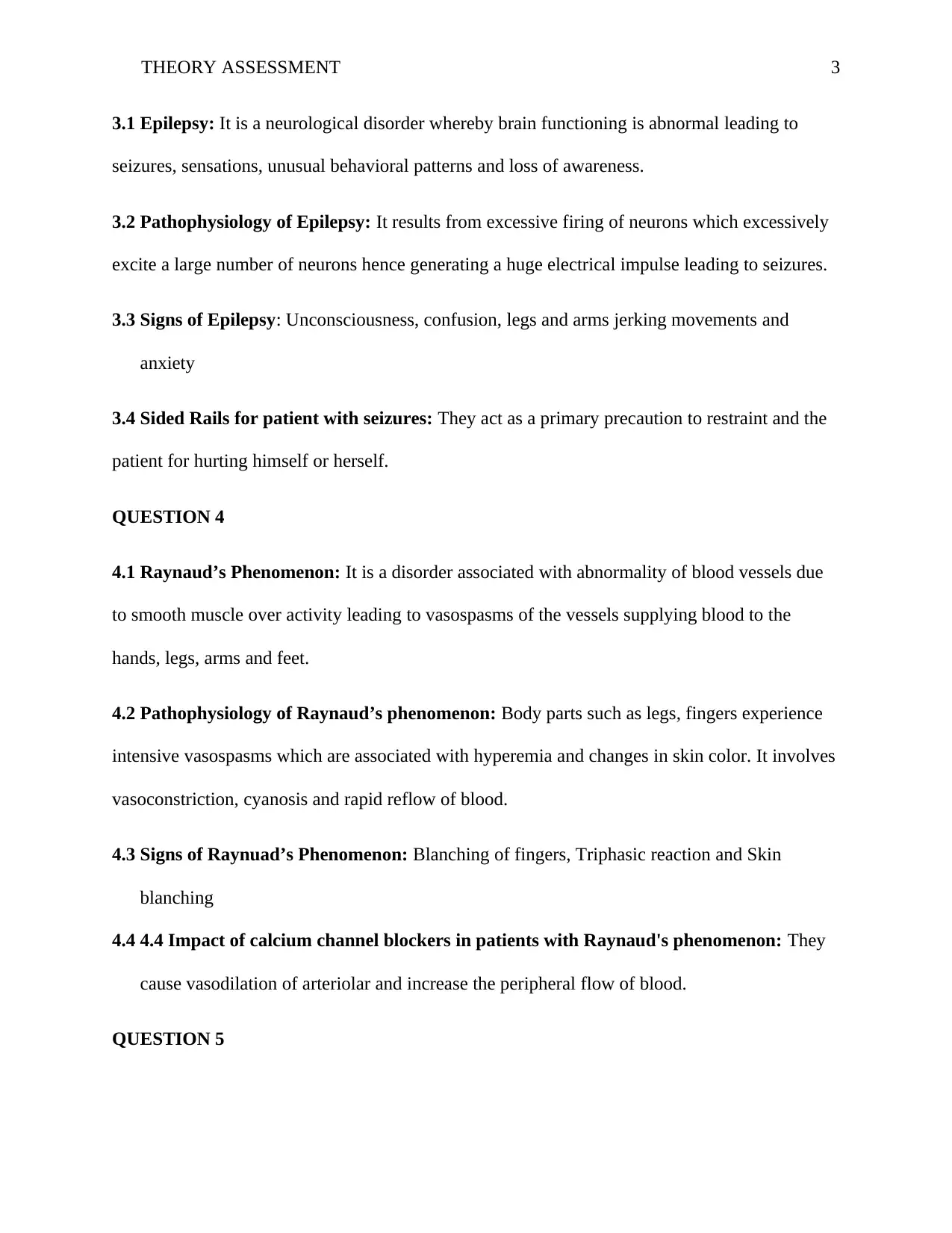
THEORY ASSESSMENT 3
3.1 Epilepsy: It is a neurological disorder whereby brain functioning is abnormal leading to
seizures, sensations, unusual behavioral patterns and loss of awareness.
3.2 Pathophysiology of Epilepsy: It results from excessive firing of neurons which excessively
excite a large number of neurons hence generating a huge electrical impulse leading to seizures.
3.3 Signs of Epilepsy: Unconsciousness, confusion, legs and arms jerking movements and
anxiety
3.4 Sided Rails for patient with seizures: They act as a primary precaution to restraint and the
patient for hurting himself or herself.
QUESTION 4
4.1 Raynaud’s Phenomenon: It is a disorder associated with abnormality of blood vessels due
to smooth muscle over activity leading to vasospasms of the vessels supplying blood to the
hands, legs, arms and feet.
4.2 Pathophysiology of Raynaud’s phenomenon: Body parts such as legs, fingers experience
intensive vasospasms which are associated with hyperemia and changes in skin color. It involves
vasoconstriction, cyanosis and rapid reflow of blood.
4.3 Signs of Raynuad’s Phenomenon: Blanching of fingers, Triphasic reaction and Skin
blanching
4.4 4.4 Impact of calcium channel blockers in patients with Raynaud's phenomenon: They
cause vasodilation of arteriolar and increase the peripheral flow of blood.
QUESTION 5
3.1 Epilepsy: It is a neurological disorder whereby brain functioning is abnormal leading to
seizures, sensations, unusual behavioral patterns and loss of awareness.
3.2 Pathophysiology of Epilepsy: It results from excessive firing of neurons which excessively
excite a large number of neurons hence generating a huge electrical impulse leading to seizures.
3.3 Signs of Epilepsy: Unconsciousness, confusion, legs and arms jerking movements and
anxiety
3.4 Sided Rails for patient with seizures: They act as a primary precaution to restraint and the
patient for hurting himself or herself.
QUESTION 4
4.1 Raynaud’s Phenomenon: It is a disorder associated with abnormality of blood vessels due
to smooth muscle over activity leading to vasospasms of the vessels supplying blood to the
hands, legs, arms and feet.
4.2 Pathophysiology of Raynaud’s phenomenon: Body parts such as legs, fingers experience
intensive vasospasms which are associated with hyperemia and changes in skin color. It involves
vasoconstriction, cyanosis and rapid reflow of blood.
4.3 Signs of Raynuad’s Phenomenon: Blanching of fingers, Triphasic reaction and Skin
blanching
4.4 4.4 Impact of calcium channel blockers in patients with Raynaud's phenomenon: They
cause vasodilation of arteriolar and increase the peripheral flow of blood.
QUESTION 5
⊘ This is a preview!⊘
Do you want full access?
Subscribe today to unlock all pages.

Trusted by 1+ million students worldwide
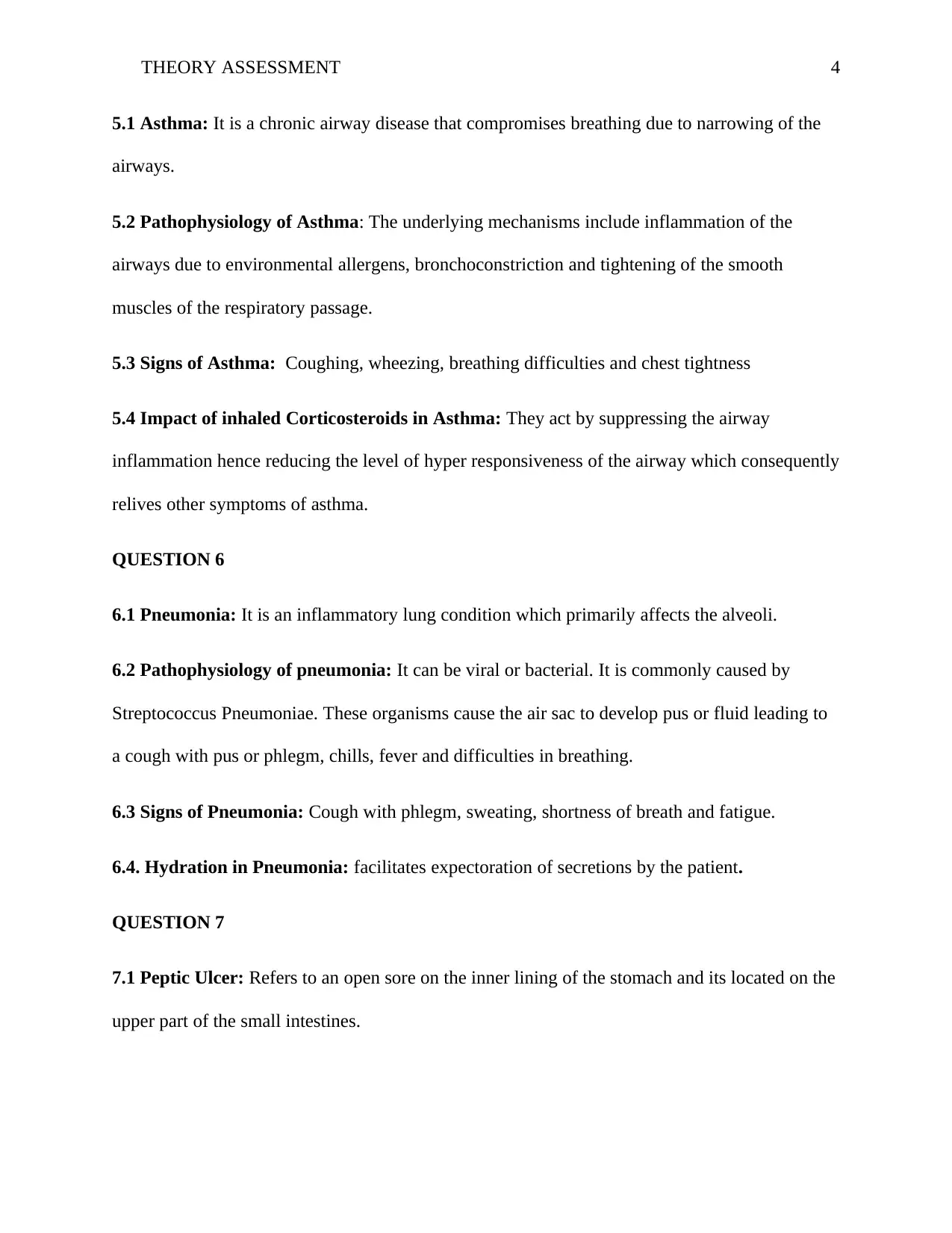
THEORY ASSESSMENT 4
5.1 Asthma: It is a chronic airway disease that compromises breathing due to narrowing of the
airways.
5.2 Pathophysiology of Asthma: The underlying mechanisms include inflammation of the
airways due to environmental allergens, bronchoconstriction and tightening of the smooth
muscles of the respiratory passage.
5.3 Signs of Asthma: Coughing, wheezing, breathing difficulties and chest tightness
5.4 Impact of inhaled Corticosteroids in Asthma: They act by suppressing the airway
inflammation hence reducing the level of hyper responsiveness of the airway which consequently
relives other symptoms of asthma.
QUESTION 6
6.1 Pneumonia: It is an inflammatory lung condition which primarily affects the alveoli.
6.2 Pathophysiology of pneumonia: It can be viral or bacterial. It is commonly caused by
Streptococcus Pneumoniae. These organisms cause the air sac to develop pus or fluid leading to
a cough with pus or phlegm, chills, fever and difficulties in breathing.
6.3 Signs of Pneumonia: Cough with phlegm, sweating, shortness of breath and fatigue.
6.4. Hydration in Pneumonia: facilitates expectoration of secretions by the patient.
QUESTION 7
7.1 Peptic Ulcer: Refers to an open sore on the inner lining of the stomach and its located on the
upper part of the small intestines.
5.1 Asthma: It is a chronic airway disease that compromises breathing due to narrowing of the
airways.
5.2 Pathophysiology of Asthma: The underlying mechanisms include inflammation of the
airways due to environmental allergens, bronchoconstriction and tightening of the smooth
muscles of the respiratory passage.
5.3 Signs of Asthma: Coughing, wheezing, breathing difficulties and chest tightness
5.4 Impact of inhaled Corticosteroids in Asthma: They act by suppressing the airway
inflammation hence reducing the level of hyper responsiveness of the airway which consequently
relives other symptoms of asthma.
QUESTION 6
6.1 Pneumonia: It is an inflammatory lung condition which primarily affects the alveoli.
6.2 Pathophysiology of pneumonia: It can be viral or bacterial. It is commonly caused by
Streptococcus Pneumoniae. These organisms cause the air sac to develop pus or fluid leading to
a cough with pus or phlegm, chills, fever and difficulties in breathing.
6.3 Signs of Pneumonia: Cough with phlegm, sweating, shortness of breath and fatigue.
6.4. Hydration in Pneumonia: facilitates expectoration of secretions by the patient.
QUESTION 7
7.1 Peptic Ulcer: Refers to an open sore on the inner lining of the stomach and its located on the
upper part of the small intestines.
Paraphrase This Document
Need a fresh take? Get an instant paraphrase of this document with our AI Paraphraser
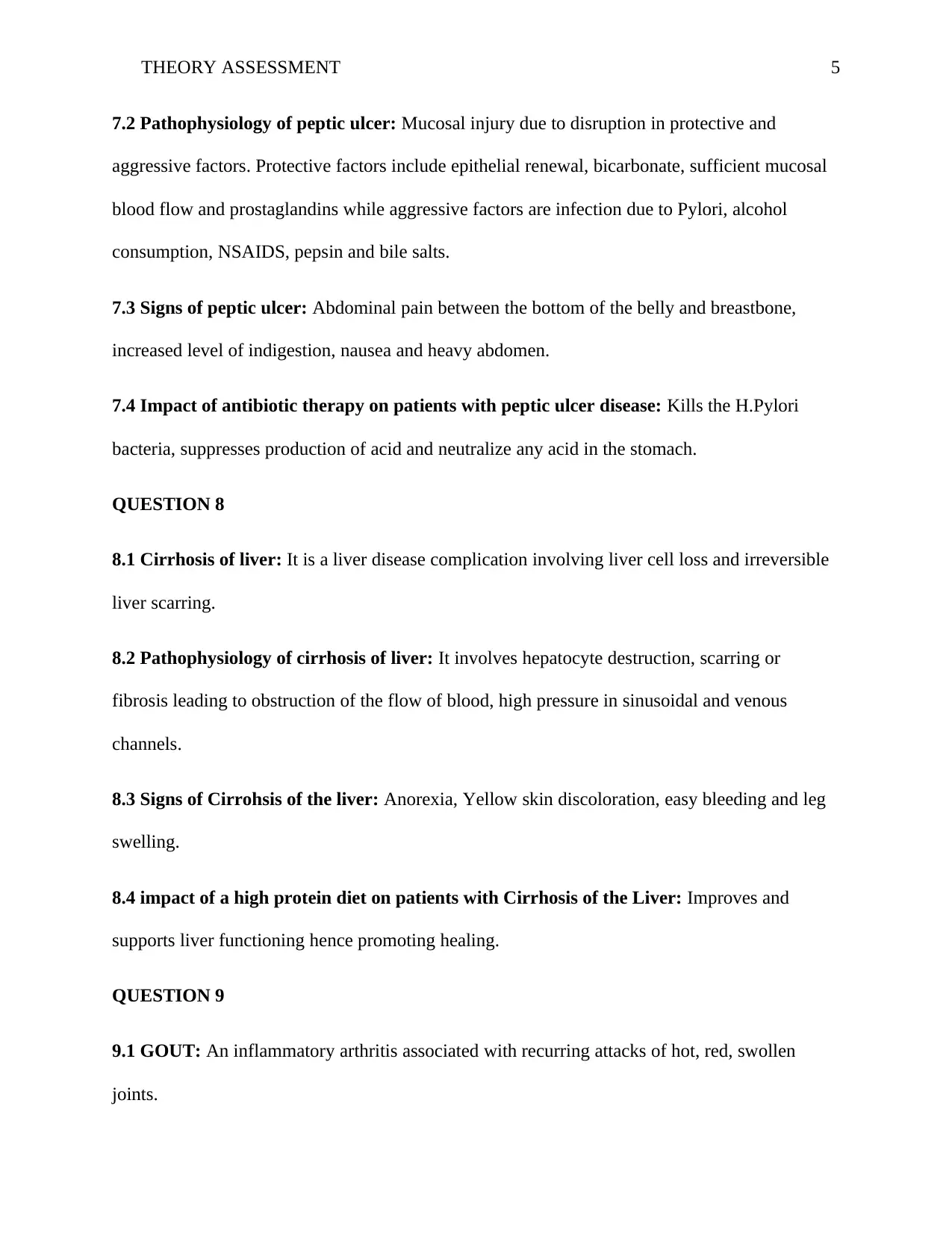
THEORY ASSESSMENT 5
7.2 Pathophysiology of peptic ulcer: Mucosal injury due to disruption in protective and
aggressive factors. Protective factors include epithelial renewal, bicarbonate, sufficient mucosal
blood flow and prostaglandins while aggressive factors are infection due to Pylori, alcohol
consumption, NSAIDS, pepsin and bile salts.
7.3 Signs of peptic ulcer: Abdominal pain between the bottom of the belly and breastbone,
increased level of indigestion, nausea and heavy abdomen.
7.4 Impact of antibiotic therapy on patients with peptic ulcer disease: Kills the H.Pylori
bacteria, suppresses production of acid and neutralize any acid in the stomach.
QUESTION 8
8.1 Cirrhosis of liver: It is a liver disease complication involving liver cell loss and irreversible
liver scarring.
8.2 Pathophysiology of cirrhosis of liver: It involves hepatocyte destruction, scarring or
fibrosis leading to obstruction of the flow of blood, high pressure in sinusoidal and venous
channels.
8.3 Signs of Cirrohsis of the liver: Anorexia, Yellow skin discoloration, easy bleeding and leg
swelling.
8.4 impact of a high protein diet on patients with Cirrhosis of the Liver: Improves and
supports liver functioning hence promoting healing.
QUESTION 9
9.1 GOUT: An inflammatory arthritis associated with recurring attacks of hot, red, swollen
joints.
7.2 Pathophysiology of peptic ulcer: Mucosal injury due to disruption in protective and
aggressive factors. Protective factors include epithelial renewal, bicarbonate, sufficient mucosal
blood flow and prostaglandins while aggressive factors are infection due to Pylori, alcohol
consumption, NSAIDS, pepsin and bile salts.
7.3 Signs of peptic ulcer: Abdominal pain between the bottom of the belly and breastbone,
increased level of indigestion, nausea and heavy abdomen.
7.4 Impact of antibiotic therapy on patients with peptic ulcer disease: Kills the H.Pylori
bacteria, suppresses production of acid and neutralize any acid in the stomach.
QUESTION 8
8.1 Cirrhosis of liver: It is a liver disease complication involving liver cell loss and irreversible
liver scarring.
8.2 Pathophysiology of cirrhosis of liver: It involves hepatocyte destruction, scarring or
fibrosis leading to obstruction of the flow of blood, high pressure in sinusoidal and venous
channels.
8.3 Signs of Cirrohsis of the liver: Anorexia, Yellow skin discoloration, easy bleeding and leg
swelling.
8.4 impact of a high protein diet on patients with Cirrhosis of the Liver: Improves and
supports liver functioning hence promoting healing.
QUESTION 9
9.1 GOUT: An inflammatory arthritis associated with recurring attacks of hot, red, swollen
joints.
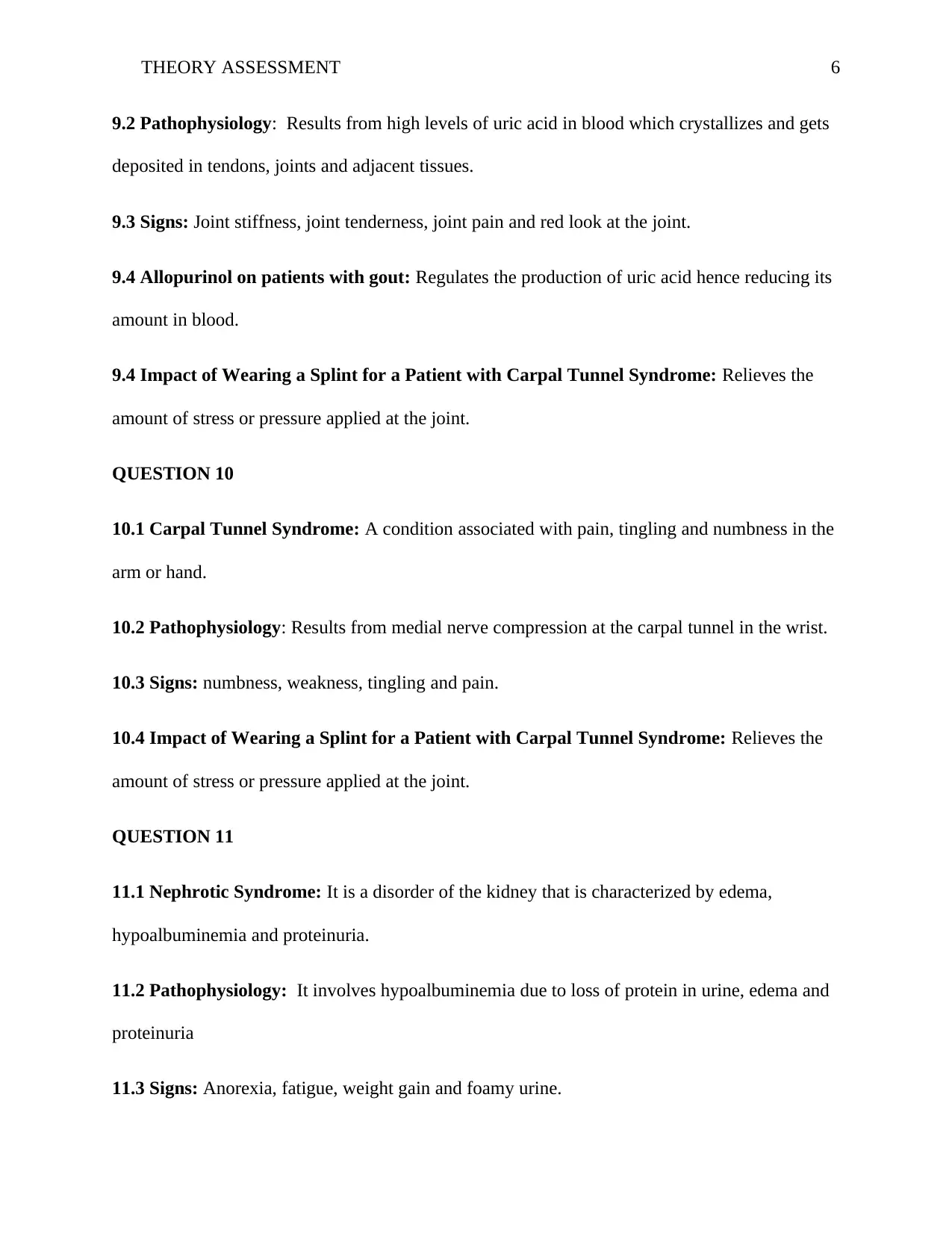
THEORY ASSESSMENT 6
9.2 Pathophysiology: Results from high levels of uric acid in blood which crystallizes and gets
deposited in tendons, joints and adjacent tissues.
9.3 Signs: Joint stiffness, joint tenderness, joint pain and red look at the joint.
9.4 Allopurinol on patients with gout: Regulates the production of uric acid hence reducing its
amount in blood.
9.4 Impact of Wearing a Splint for a Patient with Carpal Tunnel Syndrome: Relieves the
amount of stress or pressure applied at the joint.
QUESTION 10
10.1 Carpal Tunnel Syndrome: A condition associated with pain, tingling and numbness in the
arm or hand.
10.2 Pathophysiology: Results from medial nerve compression at the carpal tunnel in the wrist.
10.3 Signs: numbness, weakness, tingling and pain.
10.4 Impact of Wearing a Splint for a Patient with Carpal Tunnel Syndrome: Relieves the
amount of stress or pressure applied at the joint.
QUESTION 11
11.1 Nephrotic Syndrome: It is a disorder of the kidney that is characterized by edema,
hypoalbuminemia and proteinuria.
11.2 Pathophysiology: It involves hypoalbuminemia due to loss of protein in urine, edema and
proteinuria
11.3 Signs: Anorexia, fatigue, weight gain and foamy urine.
9.2 Pathophysiology: Results from high levels of uric acid in blood which crystallizes and gets
deposited in tendons, joints and adjacent tissues.
9.3 Signs: Joint stiffness, joint tenderness, joint pain and red look at the joint.
9.4 Allopurinol on patients with gout: Regulates the production of uric acid hence reducing its
amount in blood.
9.4 Impact of Wearing a Splint for a Patient with Carpal Tunnel Syndrome: Relieves the
amount of stress or pressure applied at the joint.
QUESTION 10
10.1 Carpal Tunnel Syndrome: A condition associated with pain, tingling and numbness in the
arm or hand.
10.2 Pathophysiology: Results from medial nerve compression at the carpal tunnel in the wrist.
10.3 Signs: numbness, weakness, tingling and pain.
10.4 Impact of Wearing a Splint for a Patient with Carpal Tunnel Syndrome: Relieves the
amount of stress or pressure applied at the joint.
QUESTION 11
11.1 Nephrotic Syndrome: It is a disorder of the kidney that is characterized by edema,
hypoalbuminemia and proteinuria.
11.2 Pathophysiology: It involves hypoalbuminemia due to loss of protein in urine, edema and
proteinuria
11.3 Signs: Anorexia, fatigue, weight gain and foamy urine.
⊘ This is a preview!⊘
Do you want full access?
Subscribe today to unlock all pages.

Trusted by 1+ million students worldwide
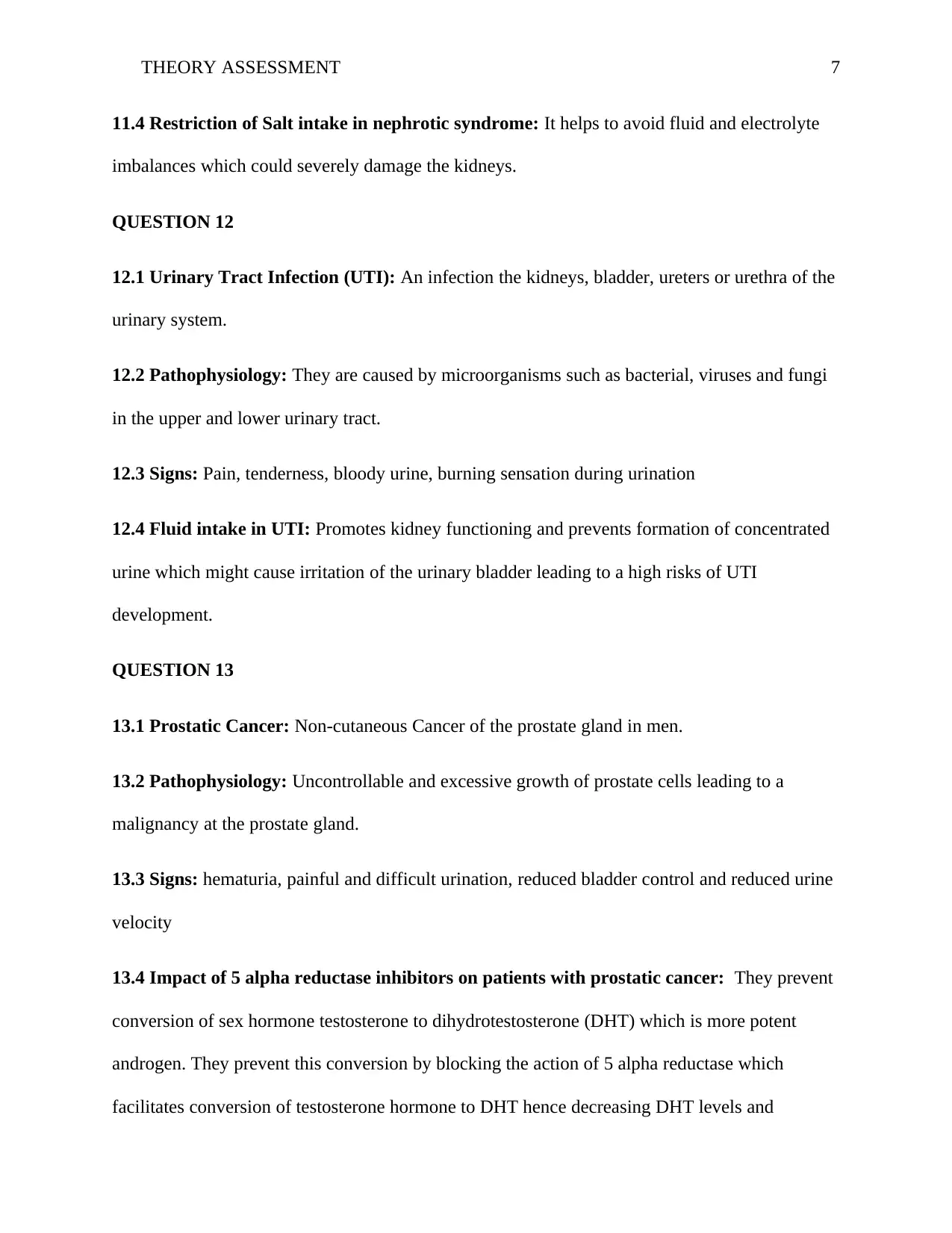
THEORY ASSESSMENT 7
11.4 Restriction of Salt intake in nephrotic syndrome: It helps to avoid fluid and electrolyte
imbalances which could severely damage the kidneys.
QUESTION 12
12.1 Urinary Tract Infection (UTI): An infection the kidneys, bladder, ureters or urethra of the
urinary system.
12.2 Pathophysiology: They are caused by microorganisms such as bacterial, viruses and fungi
in the upper and lower urinary tract.
12.3 Signs: Pain, tenderness, bloody urine, burning sensation during urination
12.4 Fluid intake in UTI: Promotes kidney functioning and prevents formation of concentrated
urine which might cause irritation of the urinary bladder leading to a high risks of UTI
development.
QUESTION 13
13.1 Prostatic Cancer: Non-cutaneous Cancer of the prostate gland in men.
13.2 Pathophysiology: Uncontrollable and excessive growth of prostate cells leading to a
malignancy at the prostate gland.
13.3 Signs: hematuria, painful and difficult urination, reduced bladder control and reduced urine
velocity
13.4 Impact of 5 alpha reductase inhibitors on patients with prostatic cancer: They prevent
conversion of sex hormone testosterone to dihydrotestosterone (DHT) which is more potent
androgen. They prevent this conversion by blocking the action of 5 alpha reductase which
facilitates conversion of testosterone hormone to DHT hence decreasing DHT levels and
11.4 Restriction of Salt intake in nephrotic syndrome: It helps to avoid fluid and electrolyte
imbalances which could severely damage the kidneys.
QUESTION 12
12.1 Urinary Tract Infection (UTI): An infection the kidneys, bladder, ureters or urethra of the
urinary system.
12.2 Pathophysiology: They are caused by microorganisms such as bacterial, viruses and fungi
in the upper and lower urinary tract.
12.3 Signs: Pain, tenderness, bloody urine, burning sensation during urination
12.4 Fluid intake in UTI: Promotes kidney functioning and prevents formation of concentrated
urine which might cause irritation of the urinary bladder leading to a high risks of UTI
development.
QUESTION 13
13.1 Prostatic Cancer: Non-cutaneous Cancer of the prostate gland in men.
13.2 Pathophysiology: Uncontrollable and excessive growth of prostate cells leading to a
malignancy at the prostate gland.
13.3 Signs: hematuria, painful and difficult urination, reduced bladder control and reduced urine
velocity
13.4 Impact of 5 alpha reductase inhibitors on patients with prostatic cancer: They prevent
conversion of sex hormone testosterone to dihydrotestosterone (DHT) which is more potent
androgen. They prevent this conversion by blocking the action of 5 alpha reductase which
facilitates conversion of testosterone hormone to DHT hence decreasing DHT levels and
Paraphrase This Document
Need a fresh take? Get an instant paraphrase of this document with our AI Paraphraser
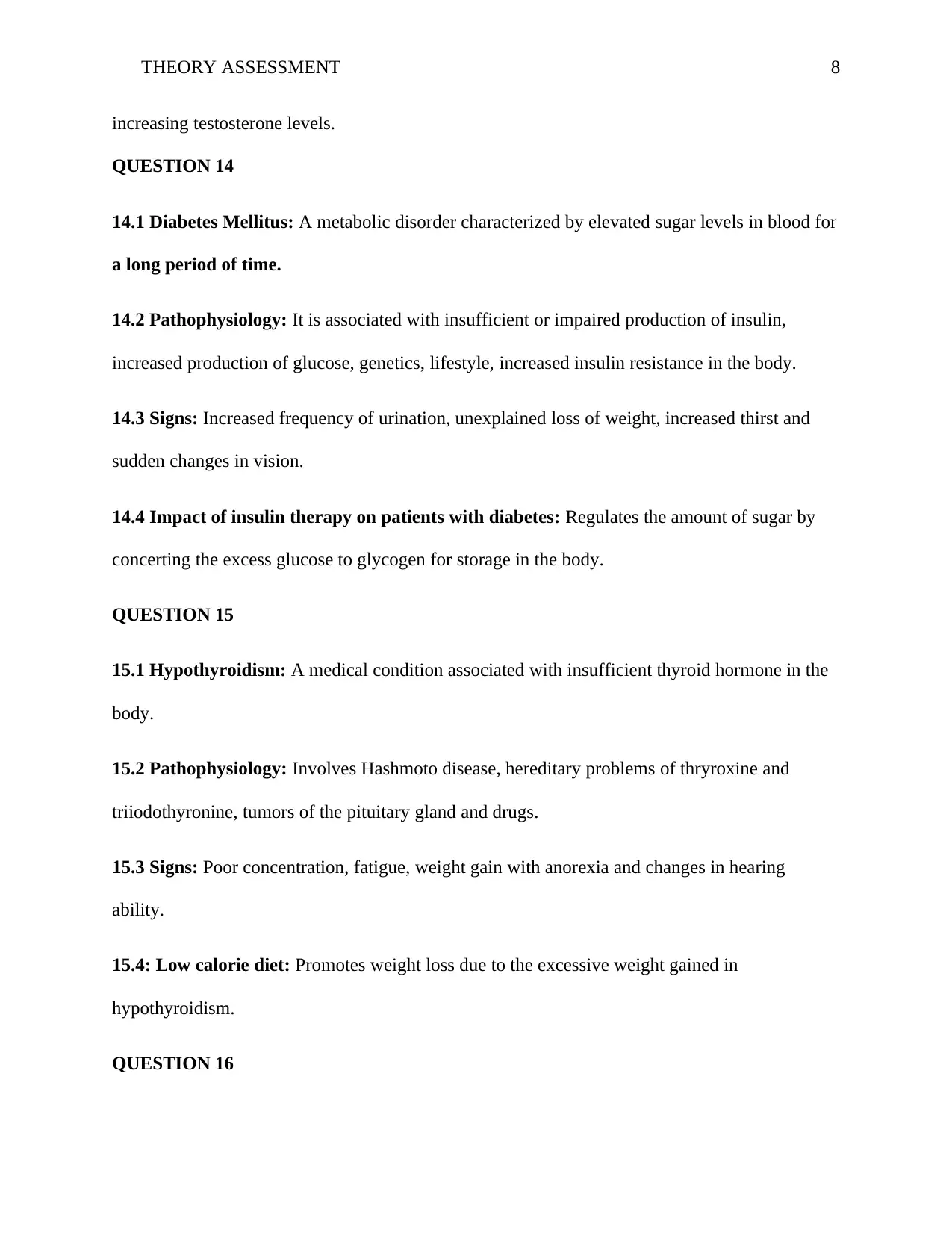
THEORY ASSESSMENT 8
increasing testosterone levels.
QUESTION 14
14.1 Diabetes Mellitus: A metabolic disorder characterized by elevated sugar levels in blood for
a long period of time.
14.2 Pathophysiology: It is associated with insufficient or impaired production of insulin,
increased production of glucose, genetics, lifestyle, increased insulin resistance in the body.
14.3 Signs: Increased frequency of urination, unexplained loss of weight, increased thirst and
sudden changes in vision.
14.4 Impact of insulin therapy on patients with diabetes: Regulates the amount of sugar by
concerting the excess glucose to glycogen for storage in the body.
QUESTION 15
15.1 Hypothyroidism: A medical condition associated with insufficient thyroid hormone in the
body.
15.2 Pathophysiology: Involves Hashmoto disease, hereditary problems of thryroxine and
triiodothyronine, tumors of the pituitary gland and drugs.
15.3 Signs: Poor concentration, fatigue, weight gain with anorexia and changes in hearing
ability.
15.4: Low calorie diet: Promotes weight loss due to the excessive weight gained in
hypothyroidism.
QUESTION 16
increasing testosterone levels.
QUESTION 14
14.1 Diabetes Mellitus: A metabolic disorder characterized by elevated sugar levels in blood for
a long period of time.
14.2 Pathophysiology: It is associated with insufficient or impaired production of insulin,
increased production of glucose, genetics, lifestyle, increased insulin resistance in the body.
14.3 Signs: Increased frequency of urination, unexplained loss of weight, increased thirst and
sudden changes in vision.
14.4 Impact of insulin therapy on patients with diabetes: Regulates the amount of sugar by
concerting the excess glucose to glycogen for storage in the body.
QUESTION 15
15.1 Hypothyroidism: A medical condition associated with insufficient thyroid hormone in the
body.
15.2 Pathophysiology: Involves Hashmoto disease, hereditary problems of thryroxine and
triiodothyronine, tumors of the pituitary gland and drugs.
15.3 Signs: Poor concentration, fatigue, weight gain with anorexia and changes in hearing
ability.
15.4: Low calorie diet: Promotes weight loss due to the excessive weight gained in
hypothyroidism.
QUESTION 16

THEORY ASSESSMENT 9
16.1 Systemic lupus erythematosus (SLE): An autoimmune disorder in which the immune
system attacks other tissues in various body parts.
16.2 Pathophysiology: Involves production of antibodies to fight other body tissues leading to
inflammation
16.3 Signs: Swollen joints, loss of hair, ulcers in the mouth and rashes
16.4 Impact of hydroxychloroquine on patients with SLE: Prevents damage of organs in a
patient with SLE
QUESTION 17
17.1 Hodgkin's disease: Lymphatic system cancer, a part of the immune system.
17.2 Pathophysiology: Involves development of a genetic mutation from a lymphocyte. The
mutation stimulates rapid multiplication of cells.
17.3 Signs: Sweating at night, drastic loss of weight, severe itching and swelling of lymph nodes
at the armpits, neck and groin.
17.4 Impact of chemotherapy on patients with hodgkin's lymphoma: Destroys cancerous
cells in different body parts.
QUESTION 18
18.1 Méniere's disease: Inner ear disorder characterized by vertigo, hearing loss, tinnitus and
ear fullness.
18.2 Pathophysiology: Involves environmental factors, genetic factors, viral infections, blood
vessel constriction and autoimmune reactions and abnormal amount of endolymph.
16.1 Systemic lupus erythematosus (SLE): An autoimmune disorder in which the immune
system attacks other tissues in various body parts.
16.2 Pathophysiology: Involves production of antibodies to fight other body tissues leading to
inflammation
16.3 Signs: Swollen joints, loss of hair, ulcers in the mouth and rashes
16.4 Impact of hydroxychloroquine on patients with SLE: Prevents damage of organs in a
patient with SLE
QUESTION 17
17.1 Hodgkin's disease: Lymphatic system cancer, a part of the immune system.
17.2 Pathophysiology: Involves development of a genetic mutation from a lymphocyte. The
mutation stimulates rapid multiplication of cells.
17.3 Signs: Sweating at night, drastic loss of weight, severe itching and swelling of lymph nodes
at the armpits, neck and groin.
17.4 Impact of chemotherapy on patients with hodgkin's lymphoma: Destroys cancerous
cells in different body parts.
QUESTION 18
18.1 Méniere's disease: Inner ear disorder characterized by vertigo, hearing loss, tinnitus and
ear fullness.
18.2 Pathophysiology: Involves environmental factors, genetic factors, viral infections, blood
vessel constriction and autoimmune reactions and abnormal amount of endolymph.
⊘ This is a preview!⊘
Do you want full access?
Subscribe today to unlock all pages.

Trusted by 1+ million students worldwide
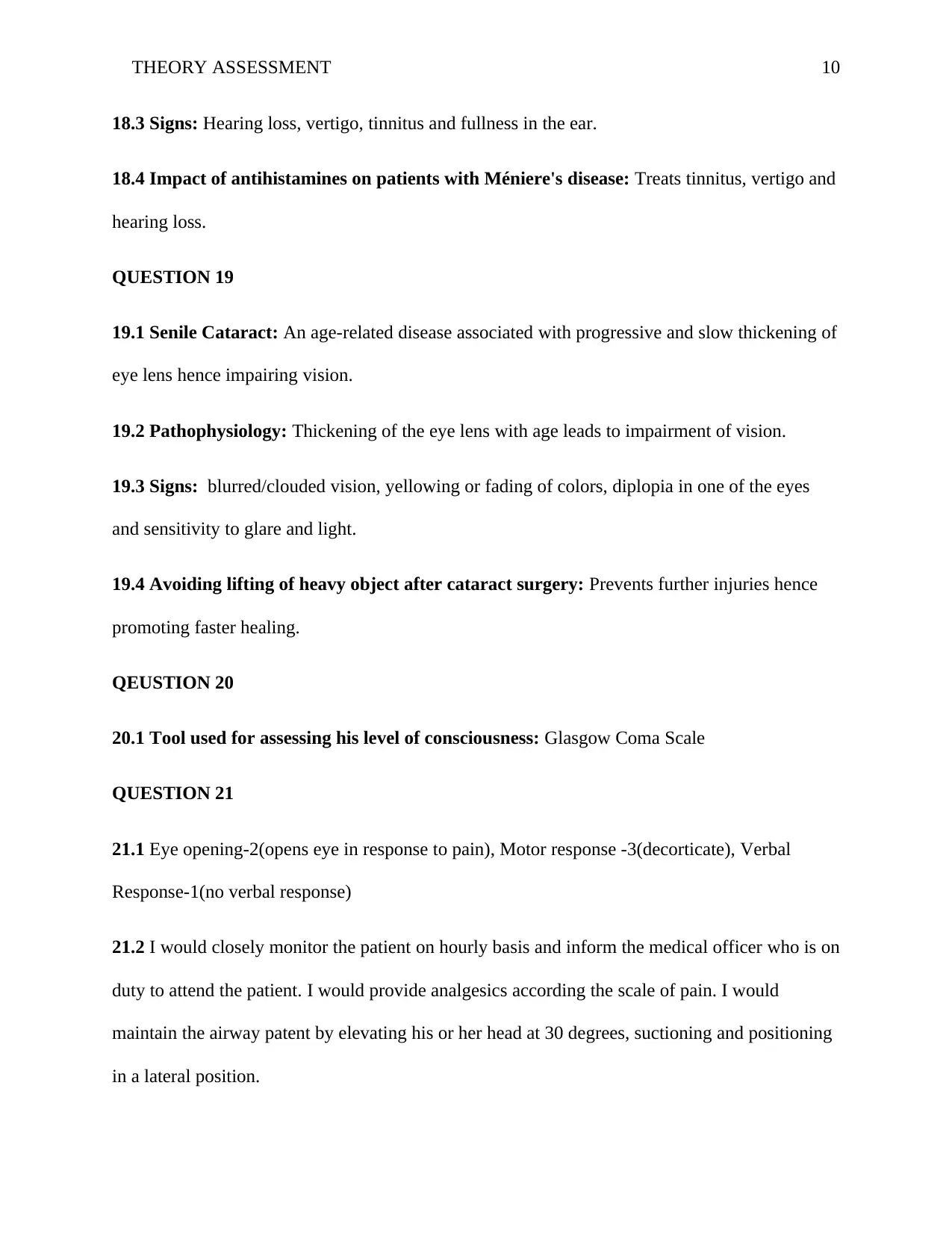
THEORY ASSESSMENT 10
18.3 Signs: Hearing loss, vertigo, tinnitus and fullness in the ear.
18.4 Impact of antihistamines on patients with Méniere's disease: Treats tinnitus, vertigo and
hearing loss.
QUESTION 19
19.1 Senile Cataract: An age-related disease associated with progressive and slow thickening of
eye lens hence impairing vision.
19.2 Pathophysiology: Thickening of the eye lens with age leads to impairment of vision.
19.3 Signs: blurred/clouded vision, yellowing or fading of colors, diplopia in one of the eyes
and sensitivity to glare and light.
19.4 Avoiding lifting of heavy object after cataract surgery: Prevents further injuries hence
promoting faster healing.
QEUSTION 20
20.1 Tool used for assessing his level of consciousness: Glasgow Coma Scale
QUESTION 21
21.1 Eye opening-2(opens eye in response to pain), Motor response -3(decorticate), Verbal
Response-1(no verbal response)
21.2 I would closely monitor the patient on hourly basis and inform the medical officer who is on
duty to attend the patient. I would provide analgesics according the scale of pain. I would
maintain the airway patent by elevating his or her head at 30 degrees, suctioning and positioning
in a lateral position.
18.3 Signs: Hearing loss, vertigo, tinnitus and fullness in the ear.
18.4 Impact of antihistamines on patients with Méniere's disease: Treats tinnitus, vertigo and
hearing loss.
QUESTION 19
19.1 Senile Cataract: An age-related disease associated with progressive and slow thickening of
eye lens hence impairing vision.
19.2 Pathophysiology: Thickening of the eye lens with age leads to impairment of vision.
19.3 Signs: blurred/clouded vision, yellowing or fading of colors, diplopia in one of the eyes
and sensitivity to glare and light.
19.4 Avoiding lifting of heavy object after cataract surgery: Prevents further injuries hence
promoting faster healing.
QEUSTION 20
20.1 Tool used for assessing his level of consciousness: Glasgow Coma Scale
QUESTION 21
21.1 Eye opening-2(opens eye in response to pain), Motor response -3(decorticate), Verbal
Response-1(no verbal response)
21.2 I would closely monitor the patient on hourly basis and inform the medical officer who is on
duty to attend the patient. I would provide analgesics according the scale of pain. I would
maintain the airway patent by elevating his or her head at 30 degrees, suctioning and positioning
in a lateral position.
Paraphrase This Document
Need a fresh take? Get an instant paraphrase of this document with our AI Paraphraser
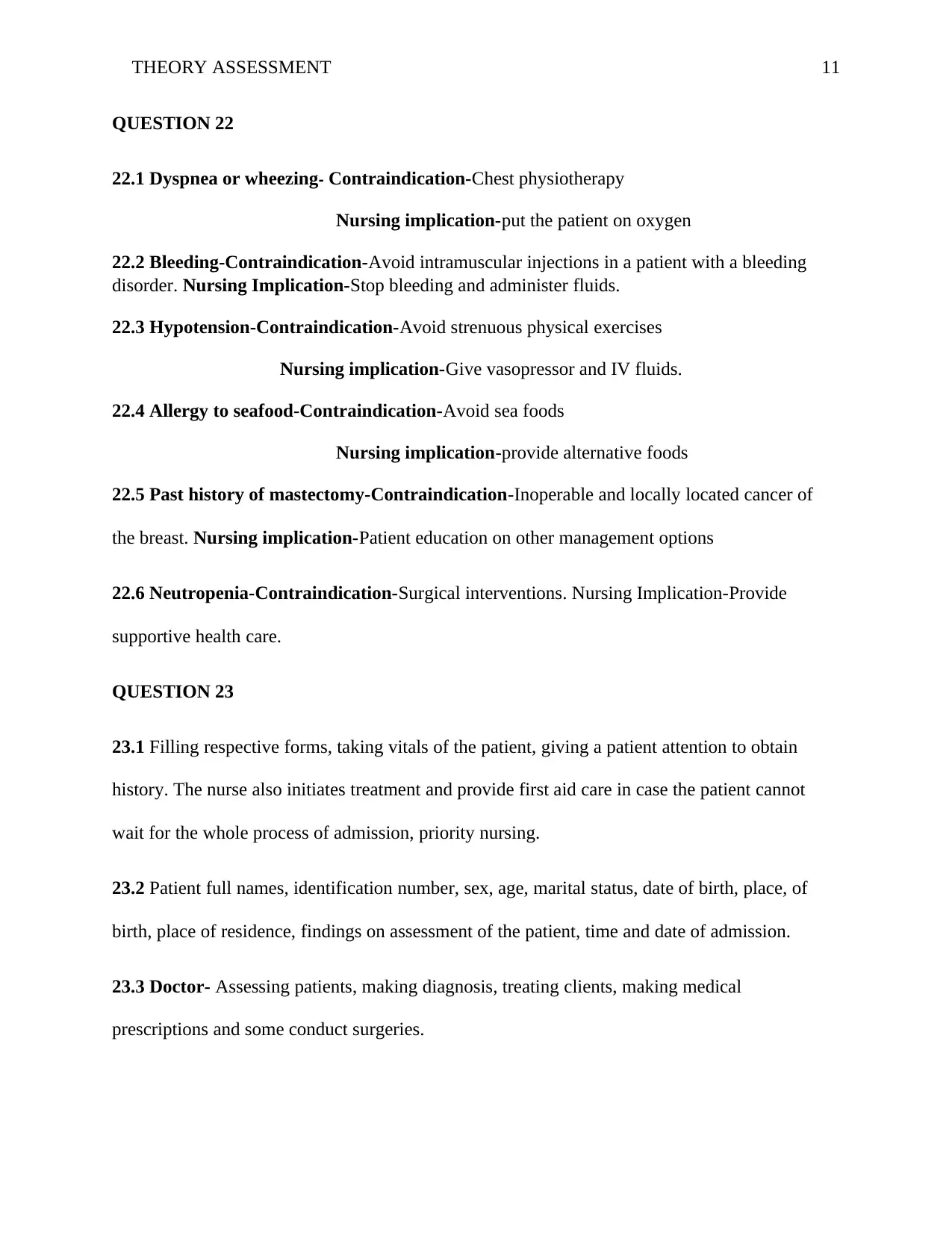
THEORY ASSESSMENT 11
QUESTION 22
22.1 Dyspnea or wheezing- Contraindication-Chest physiotherapy
Nursing implication-put the patient on oxygen
22.2 Bleeding-Contraindication-Avoid intramuscular injections in a patient with a bleeding
disorder. Nursing Implication-Stop bleeding and administer fluids.
22.3 Hypotension-Contraindication-Avoid strenuous physical exercises
Nursing implication-Give vasopressor and IV fluids.
22.4 Allergy to seafood-Contraindication-Avoid sea foods
Nursing implication-provide alternative foods
22.5 Past history of mastectomy-Contraindication-Inoperable and locally located cancer of
the breast. Nursing implication-Patient education on other management options
22.6 Neutropenia-Contraindication-Surgical interventions. Nursing Implication-Provide
supportive health care.
QUESTION 23
23.1 Filling respective forms, taking vitals of the patient, giving a patient attention to obtain
history. The nurse also initiates treatment and provide first aid care in case the patient cannot
wait for the whole process of admission, priority nursing.
23.2 Patient full names, identification number, sex, age, marital status, date of birth, place, of
birth, place of residence, findings on assessment of the patient, time and date of admission.
23.3 Doctor- Assessing patients, making diagnosis, treating clients, making medical
prescriptions and some conduct surgeries.
QUESTION 22
22.1 Dyspnea or wheezing- Contraindication-Chest physiotherapy
Nursing implication-put the patient on oxygen
22.2 Bleeding-Contraindication-Avoid intramuscular injections in a patient with a bleeding
disorder. Nursing Implication-Stop bleeding and administer fluids.
22.3 Hypotension-Contraindication-Avoid strenuous physical exercises
Nursing implication-Give vasopressor and IV fluids.
22.4 Allergy to seafood-Contraindication-Avoid sea foods
Nursing implication-provide alternative foods
22.5 Past history of mastectomy-Contraindication-Inoperable and locally located cancer of
the breast. Nursing implication-Patient education on other management options
22.6 Neutropenia-Contraindication-Surgical interventions. Nursing Implication-Provide
supportive health care.
QUESTION 23
23.1 Filling respective forms, taking vitals of the patient, giving a patient attention to obtain
history. The nurse also initiates treatment and provide first aid care in case the patient cannot
wait for the whole process of admission, priority nursing.
23.2 Patient full names, identification number, sex, age, marital status, date of birth, place, of
birth, place of residence, findings on assessment of the patient, time and date of admission.
23.3 Doctor- Assessing patients, making diagnosis, treating clients, making medical
prescriptions and some conduct surgeries.
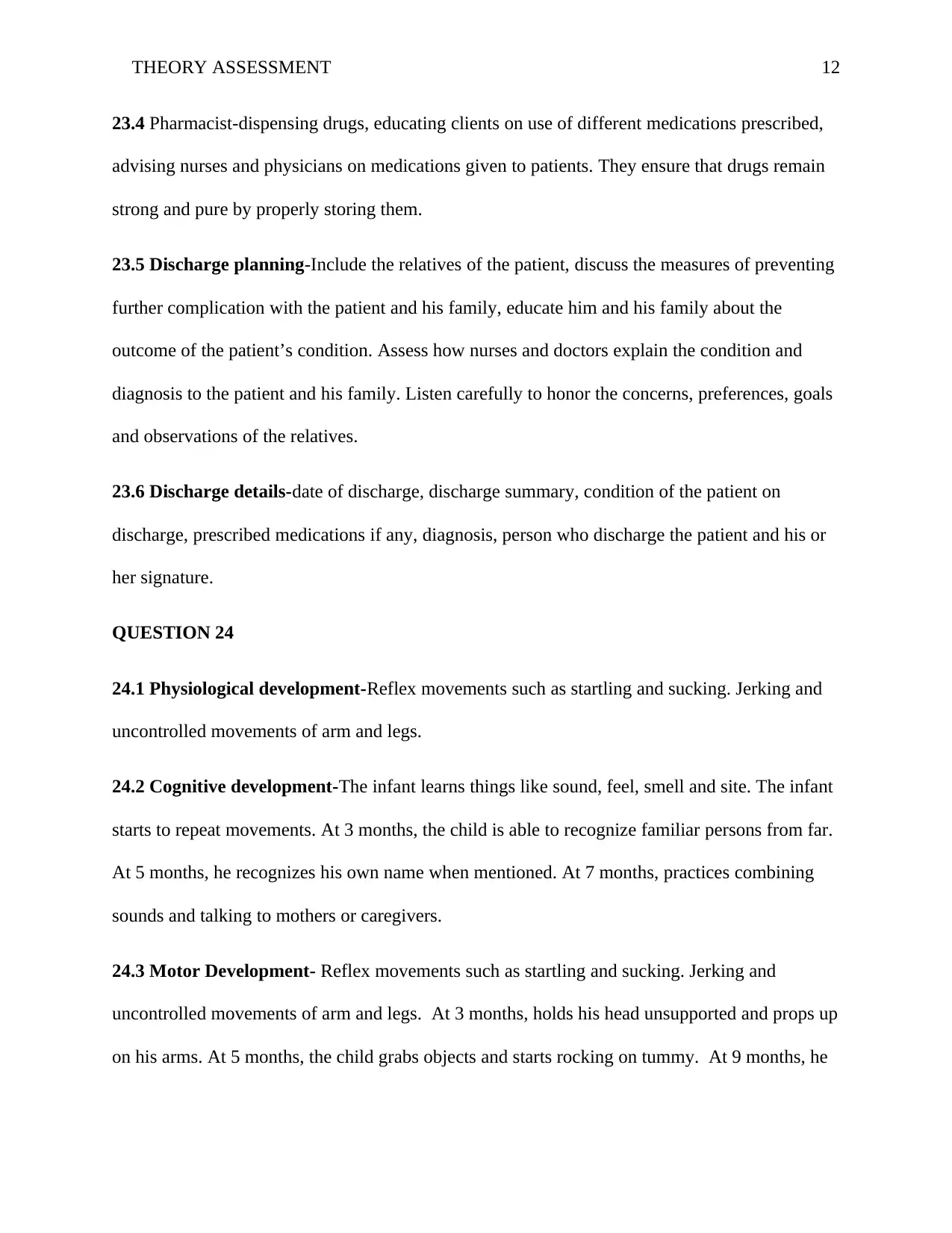
THEORY ASSESSMENT 12
23.4 Pharmacist-dispensing drugs, educating clients on use of different medications prescribed,
advising nurses and physicians on medications given to patients. They ensure that drugs remain
strong and pure by properly storing them.
23.5 Discharge planning-Include the relatives of the patient, discuss the measures of preventing
further complication with the patient and his family, educate him and his family about the
outcome of the patient’s condition. Assess how nurses and doctors explain the condition and
diagnosis to the patient and his family. Listen carefully to honor the concerns, preferences, goals
and observations of the relatives.
23.6 Discharge details-date of discharge, discharge summary, condition of the patient on
discharge, prescribed medications if any, diagnosis, person who discharge the patient and his or
her signature.
QUESTION 24
24.1 Physiological development-Reflex movements such as startling and sucking. Jerking and
uncontrolled movements of arm and legs.
24.2 Cognitive development-The infant learns things like sound, feel, smell and site. The infant
starts to repeat movements. At 3 months, the child is able to recognize familiar persons from far.
At 5 months, he recognizes his own name when mentioned. At 7 months, practices combining
sounds and talking to mothers or caregivers.
24.3 Motor Development- Reflex movements such as startling and sucking. Jerking and
uncontrolled movements of arm and legs. At 3 months, holds his head unsupported and props up
on his arms. At 5 months, the child grabs objects and starts rocking on tummy. At 9 months, he
23.4 Pharmacist-dispensing drugs, educating clients on use of different medications prescribed,
advising nurses and physicians on medications given to patients. They ensure that drugs remain
strong and pure by properly storing them.
23.5 Discharge planning-Include the relatives of the patient, discuss the measures of preventing
further complication with the patient and his family, educate him and his family about the
outcome of the patient’s condition. Assess how nurses and doctors explain the condition and
diagnosis to the patient and his family. Listen carefully to honor the concerns, preferences, goals
and observations of the relatives.
23.6 Discharge details-date of discharge, discharge summary, condition of the patient on
discharge, prescribed medications if any, diagnosis, person who discharge the patient and his or
her signature.
QUESTION 24
24.1 Physiological development-Reflex movements such as startling and sucking. Jerking and
uncontrolled movements of arm and legs.
24.2 Cognitive development-The infant learns things like sound, feel, smell and site. The infant
starts to repeat movements. At 3 months, the child is able to recognize familiar persons from far.
At 5 months, he recognizes his own name when mentioned. At 7 months, practices combining
sounds and talking to mothers or caregivers.
24.3 Motor Development- Reflex movements such as startling and sucking. Jerking and
uncontrolled movements of arm and legs. At 3 months, holds his head unsupported and props up
on his arms. At 5 months, the child grabs objects and starts rocking on tummy. At 9 months, he
⊘ This is a preview!⊘
Do you want full access?
Subscribe today to unlock all pages.

Trusted by 1+ million students worldwide
1 out of 22
Your All-in-One AI-Powered Toolkit for Academic Success.
+13062052269
info@desklib.com
Available 24*7 on WhatsApp / Email
![[object Object]](/_next/static/media/star-bottom.7253800d.svg)
Unlock your academic potential
Copyright © 2020–2025 A2Z Services. All Rights Reserved. Developed and managed by ZUCOL.
